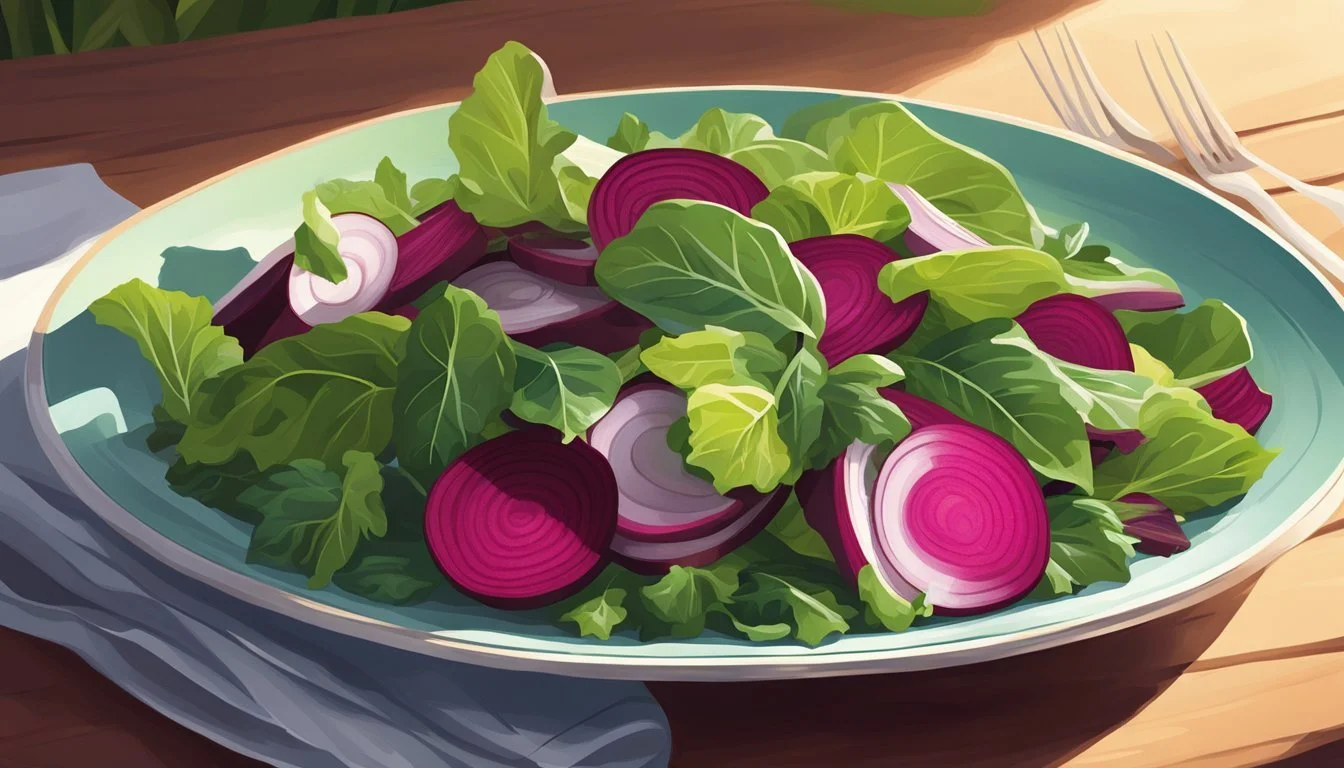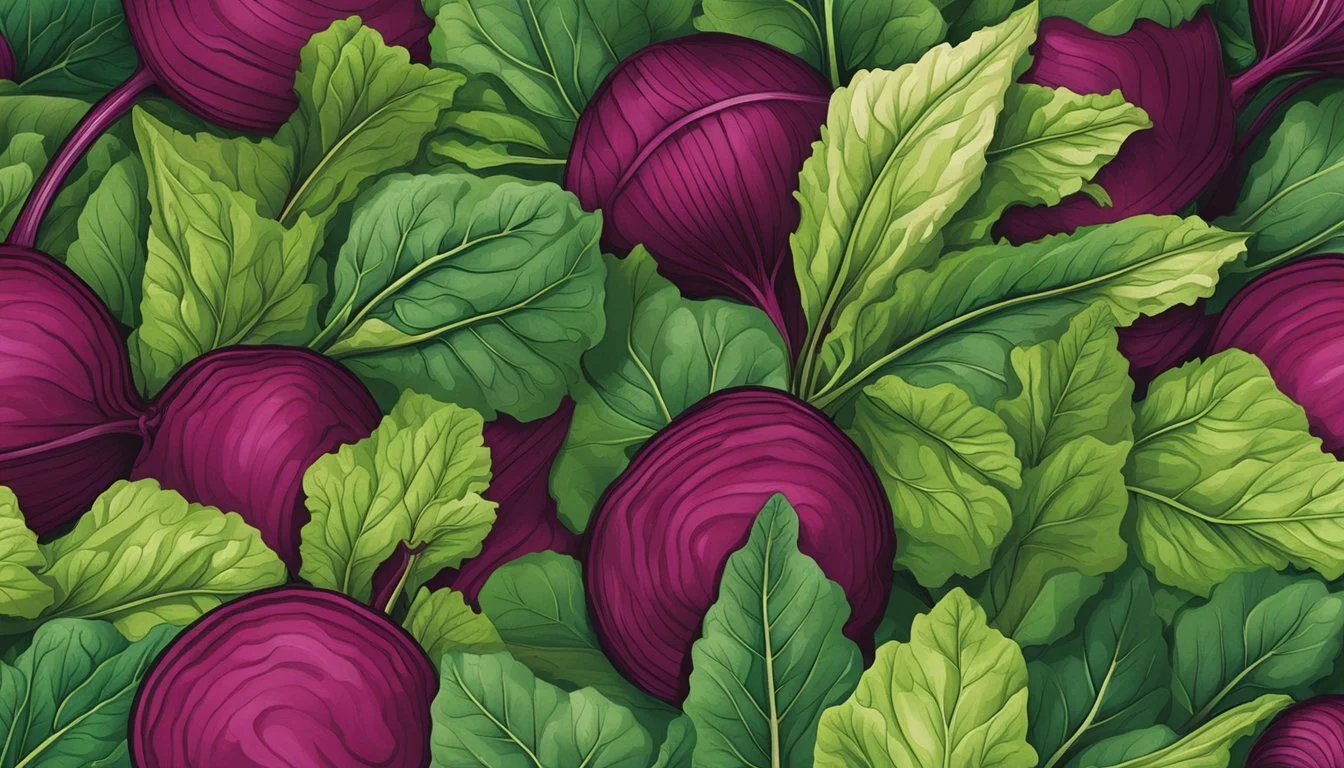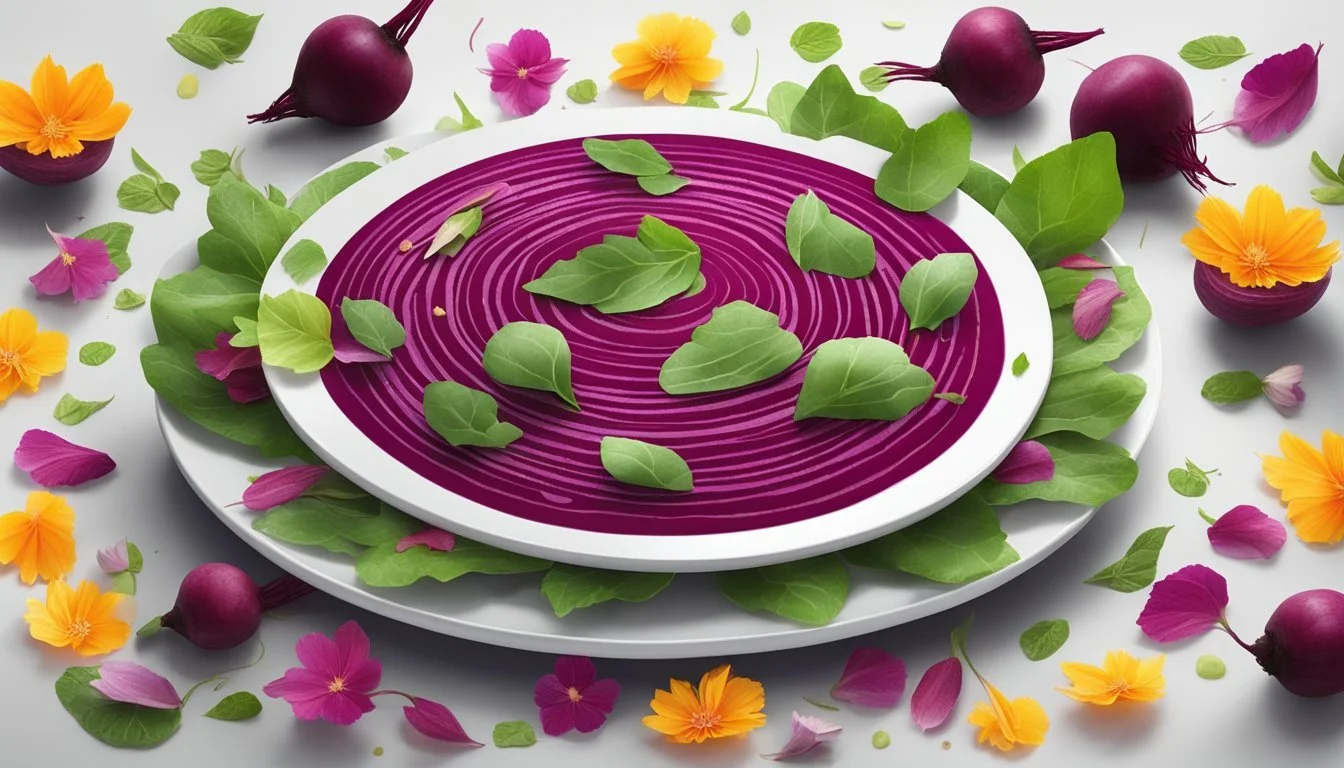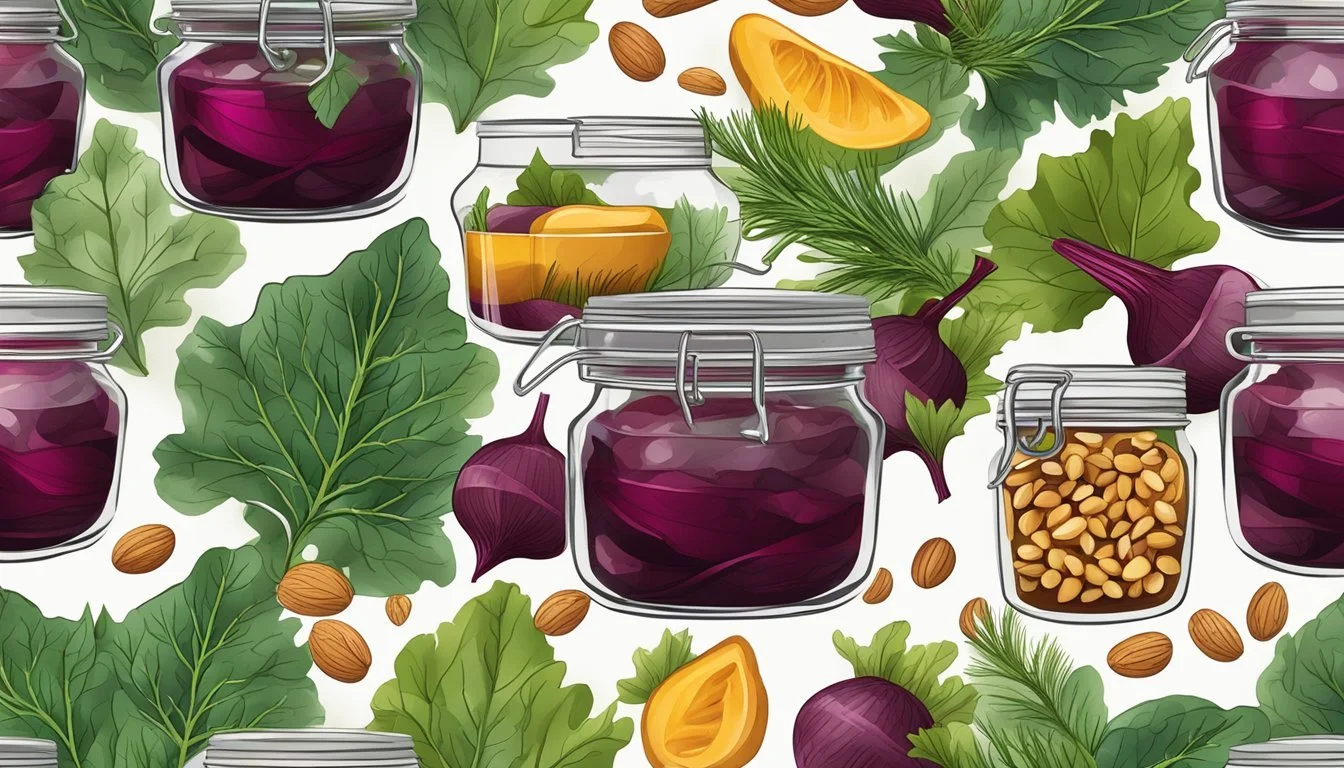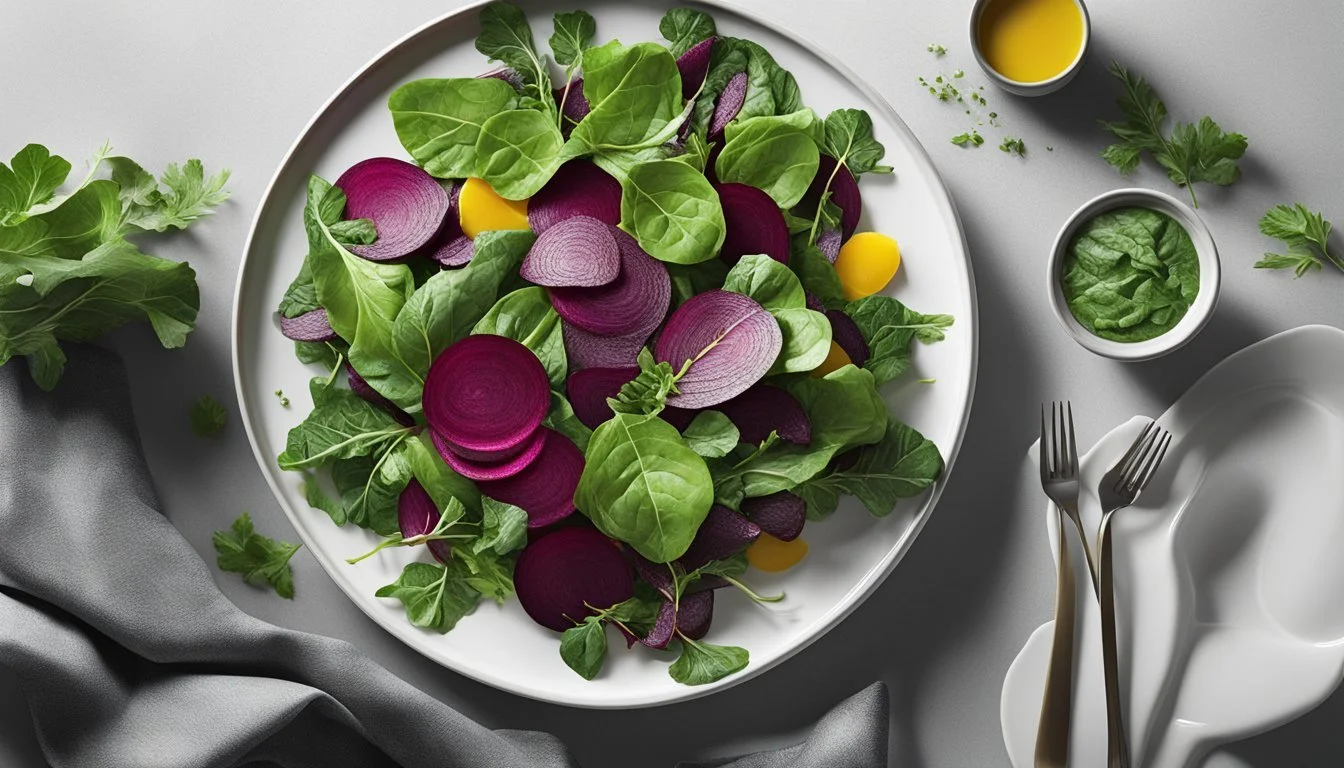Beet Leaf Salad
Discovering the Richness of Tender Greens
Beet leaf salad, often overlooked in favor of more conventional greens, is emerging as a nutritious and flavorful option in kitchens around the globe. Rather than discarding the leafy tops of beets, these tender greens can be transformed into a vibrant salad, rich in vitamins A and K, calcium, and iron. The tender, slightly bitter leaves provide a fresh, earthy flavor and a pleasing texture that pairs well with a variety of ingredients, creating a dish that is not only healthful but also full of taste.
In crafting a beet leaf salad recipe, the natural complement of feta or burrata cheese, nuts, and a mix of other vegetables, such as cherry tomatoes and olives, perfectly balances the robust flavor of the greens. Dressings for beet leaf salads (What wine goes well with salads?) often incorporate garlic, whisked smooth with salt to avoid chunks, and a simple combination of oil with an acidic element, like balsamic vinegar. This blend of flavors and textures makes the beet leaf salad a versatile dish that can serve as a hearty side or a stand-alone meal.
The preparation of beet leaf salads is as straightforward as it is enjoyable. Leaves should be washed thoroughly, patted dry, and chopped into bite-sized pieces. A well-emulsified dressing is then drizzled over the greens, ensuring that each leaf is coated lightly for maximum flavor. This salad embraces the tenderness of the greens and ensures a refreshing and nourishing eating experience.
The Essentials of Beet Leaf Salad
Beet leaf salad capitalizes on the tender beet greens that often go overlooked. These greens are nutrient-dense, packed with a variety of vitamins and minerals which contribute to a balanced diet. When preparing the foundation of a beet leaf salad, individuals may choose to combine beet greens with other leafy greens, such as baby spinach, mixed greens, arugula, or kale, to create a textured and flavorful base.
Leafy Green Nutrient Highlights Beet Greens High in antioxidants, fiber, vitamins A, C, and K Baby Spinach Rich in iron and calcium Arugula Contains folate and phytochemicals Kale Dense in vitamins A, K, C, and manganese
These greens not only offer a fresh, earthy flavor but also contribute antioxidants that combat oxidative stress, while their high fiber content aids in digestion. Moreover, the low net carb content of these greens makes them an ideal choice for individuals monitoring their carbohydrate intake.
To enhance the taste and nutritional profile, chefs may incorporate additional elements such as nuts for crunch and added protein. Grilled chicken, tofu, chickpeas, quinoa, or bacon bits can be included to suit different dietary preferences and to add a satisfying heartiness to the dish.
In dressing the salad, a simple vinaigrette made from balsamic vinegar, olive oil, garlic, a touch of mustard, honey, salt, and pepper complements the natural flavors. The dressing not only binds the salad ingredients together but also accentuates the robust notes of the featured greens.
Nutritional Profile of Beet Leaves
Beet leaves, often overlooked in favor of the vibrant beetroot, are a remarkably nutritious leafy green. They serve as an excellent source of essential nutrients and are particularly known for their high vitamin and mineral content.
Vitamins:
Vitamin A: Essential for eye health, beet leaves provide a significant amount, contributing to immune function and skin health as well.
Vitamin C: Important for collagen synthesis and immune defense, beet leaves contain a considerable dose that also acts as an antioxidant.
Folate: Crucial for DNA synthesis and repair, beet leaves are a good source of this B vitamin, which is particularly important during pregnancy.
Minerals:
Iron: Beet greens are a notable source of non-heme iron, which is vital for oxygen transport in the blood.
Calcium: Important for bone health and muscle function, beet leaves offer this mineral.
Magnesium: Involved in over 300 enzymatic reactions in the body, magnesium is found in good amounts in beet leaves.
Potassium: Essential for blood pressure regulation, beet leaves are rich in potassium.
Manganese: A trace mineral that's important for bone formation and nutrient metabolism.
Copper: Necessary for iron absorption and the formation of red blood cells.
Additionally, beet greens contain small amounts of protein, which is important for muscle repair and growth. They also provide dietary fiber, which supports digestive health. Despite their wealth of nutrients, beet leaves are low in calories, making them a nutrient-dense food choice.
The combination of these vitamins and minerals in beet leaves makes them a valuable addition to a balanced diet, contributing to overall health and well-being.
Choosing and Preparing Beets
When it comes to creating a delicious beet leaf salad, selecting the right beets and preparing them properly are crucial steps. Freshness and cooking technique greatly influence the salad's flavor and texture.
Selecting the Best Beets
To ensure a tasty beet salad, one should look for firm, smooth beets with vibrant color. Smaller beets tend to be more tender and sweeter, making them an excellent choice for salads. The greens should be fresh and perky, signifying that the beets are not outdated. Avoid beets with noticeable bruises or soft spots, as this indicates potential spoilage or a decline in quality.
Criteria to consider:
Firmness
Smooth skin without cuts
Deep, rich color
Fresh, unwilted greens attached
Preparing Beets for Salad
Cleaning and trimming beets are initial steps before cooking. One should rinse the beets under cold water, scrubbing away any dirt, and remove the greens while leaving about an inch of the stem to prevent bleeding of the color during the cooking process. Peeling isn’t necessary if one is roasting the beets, but if the recipe calls for raw or steamed beets, peeling them first is advised.
Preparation steps:
Rinse beets under cold water.
Scrub off the dirt.
Trim greens, leaving 1 inch of stem.
Peel if necessary, depending on the cooking method.
Roasting Techniques
Roasting enhances beets' natural sweetness and delivers a tender, flavorful component for salads. One should preheat their oven to a temperature between 375°F (190°C) and 400°F (205°C). Before roasting, the beets can be tossed with olive oil, salt, and pepper and then wrapped in foil to keep them moist. Roasting time varies, but generally, beets are done when they can be easily pierced with a fork.
Roasting instructions:
Preheat oven to 375°F (190°C) to 400°F (205°C).
Toss beets with olive oil, salt, and pepper.
Wrap beets in foil.
Roast until tender, generally 45-60 minutes.
Once roasted and cooled, the beets can be sliced or cut into cubes, depending on the intended presentation in the salad. Roasted beets offer a depth of flavor that complements the light bitterness of beet greens and the tangy zip of salad dressing.
Creating a Balanced Flavor Profile
When crafting the profile of Beet Leaf Salad, one must judiciously pair the tender greens with dressings and ingredients that showcase its mild, earthy flavor without overwhelming it.
Dressing Varieties
Balsamic Vinaigrette: This classic dressing is a blend of balsamic vinegar, extra virgin olive oil, a touch of honey for sweetness, and a bit of salt and pepper to taste. The rich, slightly sweet tang of the vinegar can beautifully accentuate the subtle nuances of beet greens.
Ingredients:
1/4 cup balsamic vinegar
3/4 cup extra virgin olive oil
1 teaspoon honey
Salt and pepper to taste
Apple Cider Vinaigrette: A lighter choice that infuses a zesty accent is made with apple cider vinegar, combined with olive oil, Dijon mustard for a piquant twist, and again, salt and pepper for seasoning.
Preparation:
Mix 1/4 cup apple cider vinegar with 1 tablespoon Dijon mustard.
Whisk in 1/2 cup olive oil.
Season with salt and pepper.
A simple garlic infusion can be achieved by creating a paste using finely minced garlic and salt, integrating seamlessly into either vinaigrette for a more robust flavor profile while ensuring the dressing remains smooth.
Complementary Ingredients
To maintain the salad's delicate balance, one can incorporate apple slices for natural sweetness and crispness. Toasted walnuts or pine nuts can introduce a satisfying crunch while adding nutty undertones that complement the earthy taste of the beet greens.
Texture & Flavor Enhancers:
Thinly sliced apples (for crispness and sweetness)
A handful of toasted walnuts or pine nuts (for crunch and nuttiness)
Care should be taken to avoid overpowering the inherent flavors of the beet greens. The goal is to achieve harmony between the dressing and complementary ingredients, leaving the palate gratified with the salad's fresh and multidimensional taste.
Texture and Taste Enhancers
Enhancing the natural flavors and texture of beet leaf salads requires a thoughtful choice of ingredients. Ingredients like cheese, nuts, seeds, and fresh fruits can transform the simple greens into a sophisticated dish with a rich variety of tastes and textures.
Adding Cheese for Creaminess
Cheese can add a layer of creamy texture to a beet leaf salad. Feta and goat cheese impart tangy notes, while burrata offers a soft, velvety consistency. For a dairy-free alternative, vegan feta can deliver similar creamy notes without the use of animal products.
Feta: Crumbly and sharp, balances earthy beet leaves well.
Goat Cheese: Soft and tangy, adds a creamy contrast.
Burrata: Mild and buttery, pairs with the tender textures of greens.
Vegan Feta: A non-dairy choice that still provides creaminess.
Incorporating Nuts and Seeds
Nuts and seeds contribute both a nutritional boost and a satisfying crunch to salads. Walnuts and pecans offer a hearty depth of flavor, while seeds like sunflower or pumpkin seeds supply a pleasant bite.
Walnuts & Pecans: Rich and nutty, enhance salads with their robust texture.
Sunflower & Pumpkin Seeds: Provide a crunchy element and a healthful addition to the greens.
Using Fresh Fruits
Fresh fruits not only add a burst of sweetness but also enhance the visual appeal of a beet leaf salad. Integrate dried cranberries or pomegranate for a tangy punch, or use slices of apple, pear, or orange for a juicy, fresh sweetness. Avocado oil drizzled on top can tie the flavors together with its smooth, buttery taste.
Dried Cranberries & Pomegranate: Offer a tart flavor that complements the greens.
Apples, Pears & Oranges: Introduce a fresh, sweet note.
Avocado Oil: Balances the fruit and greens with its rich texture.
Complementing Proteins for a Complete Meal
Adding a source of protein to a beet leaf salad can convert it from a simple side dish into a nutritionally balanced, satisfying meal. The tender beet leaves can be paired with both animal-based and vegetarian proteins to meet various dietary preferences and nutritional needs.
Animal-Based Proteins
Pork: For a richer flavor, one could add thin slices of cooked pork tenderloin to the salad.
Salmon: (What wine goes well with salmon?) Pan-seared salmon, flaked over the top of the salad, offers omega-3 fatty acids.
Shrimp: Grilled shrimp serve as a light, yet protein-rich topping.
Chicken Breast (What wine goes well with chicken breast?): Grilled or oven-roasted chicken (What wine goes well with roasted chicken?) breast, sliced or cubed, adds a lean protein option.
Fish: Various fish, such as grilled tilapia or cod, can be used for their high protein content.
Vegetarian Protein Options
Tofu: Marinated and grilled tofu cubes provide a substantial plant-based protein addition.
Beans: Chickpeas or black beans can offer both protein and fiber, enhancing the texture of the salad.
Quinoa: Cooked quinoa is another excellent vegetarian protein that complements the earthiness of beet greens.
Seeds and Nuts: A sprinkling of toasted seeds, such as sunflower or pumpkin, or chopped nuts like almonds or walnuts, can add a crunchy, protein-rich element.
Health Benefits and Dietary Considerations
Beet greens, the leafy tops of the beet plant, present as a nutrient-dense vegetable, offering a rich source of vitamins and minerals. They provide significant amounts of Vitamin A, Vitamin C, and Vitamin K, alongside essential minerals like iron, calcium, and magnesium. Vitamin K contributes to bone health and proper blood clotting, while Vitamin A supports eye health and immune function.
Incorporating beet greens into a vegan salad presents various health benefits, including the potential to contribute to blood pressure regulation due to their potassium content. Potassium helps to lessen the effects of sodium in the body, which is beneficial for maintaining healthy blood pressure levels.
When considering the macronutrient profile, beet greens are low in net carbs, making them suitable for individuals on carb-restricted diets. They contain negligible amounts of saturated fat, which aligns with dietary guidelines that recommend minimizing intake of these fats to support heart health.
Monounsaturated and polyunsaturated fats, found to be beneficial for heart health, are not present in significant amounts. However, these healthy fats can be easily incorporated into a salad through the addition of nuts, seeds, or olive oil dressing.
Nutrient Profile per 100g of Beet Greens:
Calories: Low
Saturated fat: Minimal
Monounsaturated fat: Not significant
Polyunsaturated fat: Not significant
Net Carbs: Low
Beet greens are an excellent choice for those seeking to enhance the nutritional value of their meals without adding excessive calories or unhealthy fats. Whether served raw or cooked, they make a versatile addition to any health-conscious individual's diet.
Innovative Beet Salad Variations
Beet leaf salads can transcend traditional boundaries with creative combinations of seasonal ingredients and thematic touches that cater to various occasions and dietary preferences.
Seasonal Salad Ideas
Spring: A Spring Beet Leaf Salad blossoms with the addition of thinly sliced radishes and fresh green peas, dressed in a light balsamic dressing spiked with a hint of honey. The sweetness and acidity of the dressing enhance the tender beet greens.
Summer: For summer, a beet leaf salad with bite-sized watermelon cubes and crumbled feta cheese is divine. A chilled beet salad dressing with mint and lime brings a refreshing zest.
Fall: Autumn ushers in a salad with roasted beetroot, crisp apple slices, and walnuts. A warm maple syrup vinaigrette balances the earthy tones of the salad.
Winter: A hearty winter salad includes roasted beet slices, pomegranate arils, and roasted pecans, all brought together by a rich balsamic and olive oil emulsion.
Thematic Salad Inspirations
Healthy Detox: A detoxifying beet leaf salad can feature a variety of sliced citrus fruits and a sprinkle of chia seeds, dressed in a revitalizing lemon and honey vinaigrette.
Heritage Dish: A heritage-inspired salad might combine beet greens with heirloom grains like quinoa or farro, enriched with a balsamic dressing that pays homage to traditional flavors.
Gourmet Fusion: In a nod to gourmet fusion, roasted beet segments can meet avocados and microgreens, complemented by a bold beet salad dressing involving champagne vinegar and Dijon mustard.
By thoughtfully pairing beet leaves with complementary ingredients and dressings, chefs can offer a year-round rotation of salads brimming with both flavor and nutrition. Each variation should consider not just taste but also how the ingredients' textures and colors combine to create a visually appealing and palate-pleasing dish.
Tips for Serving and Presentation
When preparing Beet Leaf Salad as a side dish, an important aspect to consider is make-ahead capability. One can prepare the beet leaves in advance by washing and storing them in the refrigerator. However, for optimal freshness, the salad should be assembled close to serving time.
Choosing the Bowl: Use a large, shallow dish to allow the colors and textures of the beet leaves and additional ingredients to stand out. A glass bowl can be particularly effective for showcasing the vibrant greens.
Layering the Ingredients: Start with a base of tender beet leaves. If they prefer to lessen the earthy flavor, one might mix in other greens like lettuce or kale for a balanced taste.
Adding Texture and Flavor:
Nuts: Pecans or walnuts add a satisfying crunch.
Cheese: Crumbled goat cheese provides a creamy counterpoint.
Fruits: Thin slices of apple or pear introduce a hint of sweetness.
Dressing: A citrus dressing or a balsamic vinaigrette can be drizzled over the top, ensuring not to douse the leaves to maintain their texture.
Ingredient Purpose Beet leaves Base of the salad Nuts Add crunch and nuttiness Goat cheese Creaminess and tang Apple slices Sweetness and crisp texture Dressing Compliments the salad flavors
Garnishing: Just before serving, garnish the salad with edible flowers or a sprinkle of seeds for an added visual appeal.
Serving: When the salad is served, it's best for diners to gently mix the components on their plate to fuse the flavors while maintaining the integrity of each component.
Pairing with Main Dishes
Beet leaf salad serves as a nutrient-dense green that complements a variety of main dishes. Its tender texture and subtly sweet flavor make it an excellent partner to both meat-centric and vegetarian plates.
When considering pork, chefs commonly pair beet greens with cuts like pork tenderloin. The natural bitterness of the greens balances the richness of the pork, especially when the meat is slightly smoked or glazed with a sweet sauce.
Salmon, known for its fatty profile and distinctive taste, also pairs well with beet leaf salad. The leaves’ lightness contrasts the salmon’s texture, while a lemon vinaigrette dressing can tie the dish together, bringing brightness to the palate.
For a chicken-based meal, a beet leaf salad mixed with baby spinach offers a colorful and healthful side. Nutty, grilled chicken breast harmonizes with the earthy notes in the salad. Incorporating nuts or seeds can add a pleasant crunch, enhancing the overall experience.
Fish enthusiasts can rely on a simple beet green salad to accompany their favorite fish dishes. Whether it's a tender white fish or a richer variety, the beet leaves add a fresh element. A drizzle of olive oil and a sprinkle of herbs keep the meal grounded in Mediterranean flavors.
Finally, as part of a green salad, beet leaves are a superior choice, particularly when mixed with mild lettuces. This combination forms a base that welcomes a myriad of dressings, ranging from tangy to creamy, and can be topped with various proteins or grains to transition it from a side salad to the main course.
Choosing the right pairing for beet leaf salad elevates both the salad and the main dish, resulting in a balanced and satisfying meal.
Storing Leftovers
When it comes to preserving the freshness of beet leaf salad leftovers, proper storage is paramount. Here's how one can store the remaining salad effectively:
Refrigeration: Place the leftover beet leaf salad in a sealed container and store it in the refrigerator. It will remain fresh for up to two days.
Avoid Dressing: To prevent sogginess, they should store the dressing separately and add it only when ready to serve again.
Making Beet Leaf Salad Ahead
For those preparing beet leaf salad in advance:
Dressing on the Side: Prepare and store the dressing in a separate airtight container in the refrigerator.
Layering: Assemble the greens in a serving or storage container and cover them with a damp paper towel to maintain moisture without wilting.
Component Storage Method Duration Beet leaves Refrigerator with damp paper towel Up to 2 days Prepared dressing Separate airtight container Matched to leaf's storage
One should keep the components apart to ensure the salad remains as crisp and refreshing as when first tossed. This method ensures that the beet leaf salad retains its texture and nutritional value when they serve it again. Trusting these techniques ensures the remaining beet leaf salad is enjoyed to its fullest potential without compromise.
Frequently Asked Questions
In this section, readers will find straightforward answers to common queries regarding beet leaf salad, with a focus on nutritional content and how to customize the recipe to suit various dietary needs and preferences.
Addressing Common Concerns
Are beet greens nutritious?
Beet greens are a highly nutritious addition to a salad. They offer a rich source of vitamin K, essential for blood clotting and bone health, with 100 grams providing over 300% of the daily value. Furthermore, they contain other nutrients such as fiber, vitamins A, C, calcium, and iron.
What about sodium and fat content?
Beet greens themselves are low in sodium and fat, making them a heart-healthy choice. They are naturally free from saturated fat, while polyunsaturated and monounsaturated fats are not present in significant amounts. Salads with beet greens should be dressed thoughtfully to keep sodium and fat in check.
Recipe Variations and Substitutions
Can I substitute different cheeses or nuts in the recipe?
Absolutely. For those looking to reduce fat content, consider using low-fat cheese options. Nuts can be varied based on preference or to alter the fatty acid profile; walnuts or almonds provide healthy polyunsaturated and monounsaturated fats, respectively.
What if I want to make the salad low-carb?
Beet greens are naturally low in carbohydrates. To maintain a low-carb salad, exclude or minimize ingredients like croutons or high-carb dressings. Incorporate proteins and fats, such as goat cheese and a vinaigrette made with olive oil, to keep the salad satisfying yet low in carbohydrates.
Conclusion
Incorporating beet greens into salads is a savvy choice for those seeking to enhance their nutrient intake without adding excessive calories. Beet greens are noted for their nutrient-dense composition, offering a wealth of essential vitamins and minerals such as vitamin A, vitamin C, and iron, all while being remarkably low in calories.
For those keen on preparing a beet salad, utilizing these tender greens can impart a fresh, earthy flavor paired with a pleasing texture. The process of creating a beet salad can involve roasting beets, which deepens their sweetness, adding a robust flavor profile to the dish. A typical beet salad recipe might suggest tossing the roasted beets with the greens and enhancing the salad with ingredients like nuts or cheese for added complexity and mouthfeel.
A homemade dressing can be the final touch, with vinaigrettes being a popular choice due to their ability to complement the natural flavors of the beet greens without overwhelming them. Following these steps ensures that the salad maintains a balance between nourishing ingredients and delectable taste – a harmony that epitomizes what a well-crafted salad should offer.
For salad enthusiasts and health-conscious diners alike, beet leaf salads stand out as a versatile and beneficial addition to the culinary repertoire. They demonstrate that satisfying flavors and nutritional advantages can be achieved simultaneously, lending credence to the embracing of beet greens in everyday cooking.

